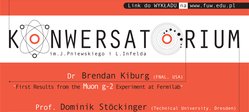
Wykład otwarty
First results from the Muon g-2 experiment at Fermilab, Theory predictions and interpretations of the Fermilab g-2 result
dr Brendana Kiburga (FNAL, USA)
prof. Dominika Stoeckingera (Technical University Dresden, DE)
26 kwietnia 2021 16:30
on-line, via Zoom
Najbliższe Konwersatorium im. Jerzego Pniewskiego i Leopolda Infelda Wydziału Fizyki UW odbędzie się 26 kwietnia o godz. 16.30. Tym razem wysłuchamy dwóch wykładów dotyczących gorącego w ostatnich dniach tematu jakim jest, określany hasłowo, problem g-2 dla mionu. Jest to temat interdyscyplinarny, ważny nie tylko dla fizyków pracujących w dziedzinie cząstek elementarnych.
Będą to:
- First results from the Muon g-2 experiment at Fermilab, dr Brendana Kiburga (FNAL, USA)
- Theory predictions and interpretations of the Fermilab g-2 result, prof. Dominika Stoeckingera (Technical University Dresden, DE).
Zapraszamy do dołączenia do spotkania 15-30 minut przed rozpoczęciem wykładu, by porozmawiać lub "poczatować" w nieformalnej atmosferze.
Zoom: https://us02web.zoom.us/j/93881687598?pwd=UmFhVUdVSXhnQ2tIVVozNmowSUNtZz09
Nr identyfikacyjny: 938 8168 7598
Kod dostępu: prv316
Pozdrawiamy serdecznie,
Barbara Badełek
Jan Chwedeńczuk
Jan Kalinowski
Jan Suffczyński
Dr Brendan Kiburg (Fermilab): First results from the Muon g-2 experiment at Fermilab
The Muon g-2 Experiment recently reported a new measurement of the anomalous magnetic moment of the muon with a precision of 0.46 parts per million. This result is in good agreement with the previous experimental measurement from Brookhaven National Laboratory and has increased the tension with the Standard Model calculation to 4.2 standard deviations, strengthening hints of New Physics. This talk will give a brief description of the experimental history and will provide an overview of the measurement challenges and analysis techniques.
Prof. Dominik Stoeckinger (TU Dresden): Theory predictions and interpretations of the Fermilab
g-2 result.
The quantity g-2 of the muon is sensitive to all known elementary particles and all forces between them. In the Standard Model of particle physics, a highly precise prediction is possible. The observed deviation from the Standard Model might be due to additional, so far unknown particles or forces. The talk will briefly explain the status of the Standard Model prediction and give an overview of potential implications for physics beyond the Standard Model.

